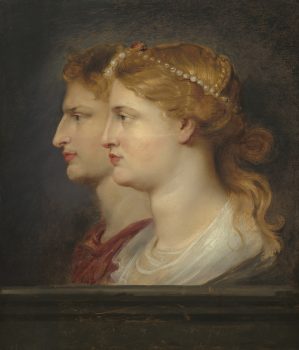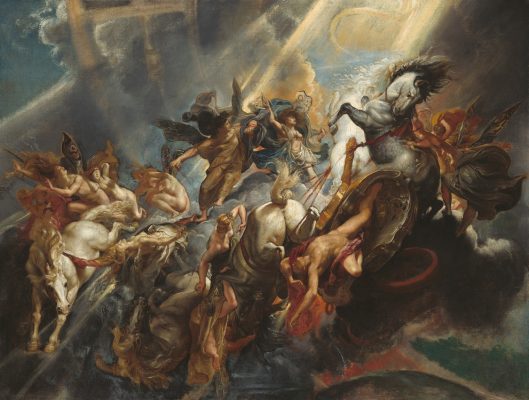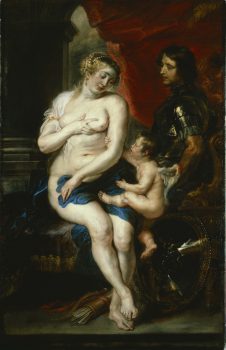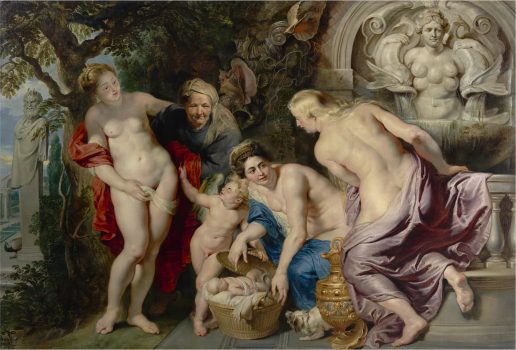
"Crash of Paeton" Paeter · Paul · Rubens 1604/05 Oil on canvas / Canvas
Washington, National Gallery Courtesy National Gallery of Art, Washington
At the National Museum of Western Art, "Rubens Exhibition – The Birth of Baroque" will be held from October 16 (Tue) 2018 to January 20 (Sun) 2019. We introduce the exhibition composition and attractions of this exhibition.
About Rubens
The name of Peter, Paul Rubens (1577-1640) is known in Japan by the cartoon "Dog of Flanders." It is the creator of the altarpiece of the Virgin Cathedral, which the hero's Nero Boy keeps seeing at first sight, in the final round he can be sold with his dog Patrasche.
Rubens was a painter of 17th century Europe, a magnificent and spectacular art style called Baroque, prospered and was later called "King of Painters as King's Painter" later. He studied in Italy, the center of baroque art, and further influenced Italian young painters.
This exhibition will focus on the interactive relationship between Rubens and Italy. It will display Rubens' works with works of ancient sculpture, Italian art of the 16th century preceding him, as well as works of artists from Italy and Baroque from the same era.
Exhibit composition
- Chapter 1 Learning about ancient art and Italian art by Rubens
- Chapter 2 Saints as Heroes: Religious Paintings and Baroque
- Chapter 3 Portrait
- Chapter 4 Rubens' brush strokes: vitality the felt pen brings to the screen
- 5 Hercules and male nude
- Chapter 6 Venus and Female Nudity
- Chapter 7 Mythical Declaration
· Chapter 1 Learning about ancient art and Italian art by Rubens
We will exhibit Rubens' work by showing ancient sculptures, replication by Rubens of works of the 16th century, and the results of studying works of the preceding era.
"Death of Seneca"

"Death of Seneca" Peeter · Paul · Rubens 1615/16 Oil on canvas / Madrid, Prado Museum © Madrid, Museo Nacional del Prado
Seneca was a model philosopher in the intellectual circle of Antwerpen, to which Rubens also belonged. That attitude quoted the famous ancient sculpture as it is, but the head is based on another ancient sculpture that was considered as Seneca statue then. Rubens himself drawn only the head, the rest by the workshop.
"Agrippina and germanics"

"Agrippina and Germanics" Peter · Paul · Rubens · 1614 · Oil paint / board Washington, National Gallery Courtesy National Gallery of Art, Washington
Drawing the two in profile This picture is based on the form of an ancient cameo and tells the admiration for Rubens' ancient art. However, skin and hair are overflowing with animation, it seems that ancient sculpture has been revived.
· Chapter 2 Saints as Heroes: Religious Painting and Baroque
This chapter features religious themes. Rubens gave religious painting a pleasant and classic character. We will show Rubens' work, along with his work and the work of Italy that he influenced.
"Christ mourning"

"Mourning of Christ" Peeter · Paul · Rubens · 1603 Oil on canvas / Canvas Rome, Borghese Museum of Art
The fact that Christ is placed on the sarcophagus implies burial and at the same time symbolizes that the bread and wine sanctified at the altar during the mass changes to the flesh and blood of Christ. Relationship with the Christian interpretation of the philosophy of the store phrase is pointed out in the image depicted in the ancient sarcophagus.
· Chapter 3 Portrait
From portrayal of families and close friends to public portraits, we will exhibit portraits of various personality. You should be able to perceive the breadth of Rubens' portrait expression.
"Two children sleeping"

"Two children sleeping" Paeter · Paul · Rubens 1612 – 13 Oil painting / board Tokyo, National Museum of Western Art, Tokyo
With this picture you will also be able to sense the affection for two young people. However, this picture was drawn to serve as a sample for producing a large work, and there is a work where the same head appears as an angel or an infant Jesus.
"Portrait of Clara Serena Rubens"

"Portrait of Clara, Serena, Rubens" Peter Paul Rubens 1615 – 16 Canvas Vienna lined with oil paint / board, Marquis of Liechtenstein © LIECHTENSTEIN. The Princely Collections, Vaduz-Vienna
In fact she seems to be very close and the sense of physical and psychological distance with the viewer is the attraction of this picture. The fact that Rubens painted this picture as his own enjoyment can be seen from the finish that looks like it is incomplete.
· Chapter 4 Rubens' brush strokes: vitality that a felt pen brings to the screen
This chapter develops in accordance with the word "painter's enthusiasm". This word, written by Rubens' biographers, is a good representation of the lively and dense movement that his work might crop.
"Crash of Paeton"

"Crash of Paeton" Peeter · Paul · Rubens 1604/05 Oil on canvas / Washington, National Gallery Courtesy National Gallery of Art, Washington
This work draws that moment when the thunder was released. Due to many reworks on the screen, Rubens knows that he thought carefully and made a composition.
· Chapter 5 Hercules and male nude
This chapter will focus on male nude. Rubens found an ideal man 's image for ancient sculptures such as "Hercules of Farnese". Many nude men by Italian painters after Rubens will also be exhibited.
· Chapter 6 Venus and Female Nudity
We feature female nude. Here, we will display the ancient sculpture of the whole image of female nude as a theme in the same space as Rubens and painters of Italian painters.
"Venus, Mars and Cupid"

"Venus, Mars and Cupid" Peeter · Paul · Rubens around 1635 Oil on canvas / Canvas London, Darridge Picture Gallery By Permission of the Trustees of Dulwich Picture Gallery.
Again Mars puts a shield and Cupid behind him is removing the fasteners of the armor. Mars is under Venus and peace is kept, so she is breastfeeding to another cupid with confidence.
· Chapter 7 Mythical Declaration
We will display other mythological subjects drawn by Rubens with ancient sculptures. These works tell us that he was familiar with not only the expression of ancient sculpture but also ancient literature, and he tells us that his modeling is rooted in intelligence.
"Daughters of Cecropus to discover Elktonios"

"Daughters of Cecropus to discover Elktonios" Peter-Paul Rubens 1615 – 16 Oil on canvas Vienna, Liechtenstein's curtain collection © LIECHTENSTEIN. The Princely Collections, Vaduz-Vienna
In Elktonios who was in the basket there was a snake's tail instead of the foot. The sculpture on the left of the screen represents animal libido, the rightmost sculpture represents the goddess of the earth, symbolizing the beginning of the story. The three sisters seem to have blood passed through ancient sculpture.
"Mars and Rare Sylwia"

"Mars and Rare Sylwia" Peter Paul Rubens 1616-17 Oil on canvas Vienna, Liechtenstein's curtain collection © LIECHTENSTEIN. The Princely Collections, Vaduz-Vienna
Normally Mars starts to sleep while Rae Sylwia is asleep on the banks of the fountain, but here the shrine is set in the shrine. Mars, who came on the clouds, got off and Cupid joined the two.
Summary
| Exhibition name | Rubens Exhibition – The Birth of Baroque |
| A session | October 16 (Tuesday) 2018 to January 20 (Sunday) 2019 |
| Venue | National Museum of Western Art Ueno Park 7-7, Taito-ku, Tokyo |
| Opening hours | 9: 30 – 17: 30 (Friday, Saturday until 20 o'clock, but 11/17 is until 17:30) ※ Admission until 30 minutes before closing |
| closing day | Monday (except 12/24, January 14 is open) 12 / 28-1 / 1, 1/15 |
| Admission fee | ※ () in parenthesis · group fee ※ Free from junior high school students |
| inquiry | 03-5777-8600 (Hello dial) |
| URL | http://www.tbs.co.jp/rubens2018/ |


